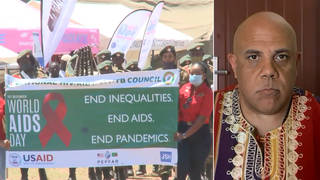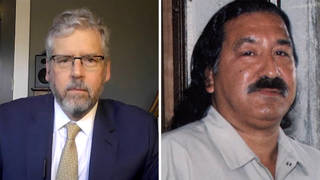
Topics
Guests
- James Kingstate campaigner for the Oakland-based Ella Baker Center for Human Rights and a member of the Stop San Quentin Outbreak Coalition.
Prisons across the U.S. are facing their greatest swell in COVID-19 cases since the beginning of the pandemic. Nearly a quarter-million incarcerated people in the U.S. have been infected with COVID-19, according to the Marshall Project, and advocates are pushing for incarcerated people to be prioritized in the country’s vaccine rollout. All of California’s state prisons have active coronavirus cases, but the California Department of Corrections is continuing to transfer incarcerated people between institutions. San Quentin State Prison has begun the transfer of nearly 300 incarcerated people to other institutions, against the advice of health professionals and despite the outcry of prisoners, after a California appeals court ordered prison authorities to cut the population of the overcrowded prison in half in October after a first wave of the coronavirus at the prison left 28 people dead. “The outbreak throughout the 34 prisons is surging in a way that shows that overcrowded, unventilated prisons throughout the state are not safe to protect people from COVID-19, something that public health officials have been saying for the past nine months,” says James King, a state campaigner for the Oakland-based Ella Baker Center for Human Rights and a member of the Stop San Quentin Outbreak Coalition.
Transcript
AMY GOODMAN: This is Democracy Now!, democracynow.org, The Quarantine Report. I’m Amy Goodman, with Juan González, as we turn to the COVID-19 crisis unfolding in prisons and jails.
As the U.S. death toll tops 300,000 and U.S. healthcare workers begin receiving the coronavirus vaccine this week, advocates are pushing for incarcerated people to be prioritized in the vaccine rollout. This comes as prisons face their greatest swell in COVID cases since the beginning of the pandemic. Nearly a quarter-million incarcerated people in the U.S. have been infected with COVID-19, this according to the Marshall Project.
As infection numbers soar in California, all the state’s prisons have active coronavirus cases. Infections were up 130% last week. Despite this, the California Department of Corrections is continuing to transfer incarcerated people between institutions — behavior that helped spread the virus in the prison system in the first place. On Monday, San Quentin State Prison began the transfer of nearly 300 prisoners to other institutions, against the advice of health professionals and despite the outcry of the prisoners. This comes after a California appeals court ordered prison authorities to cut the populations of the overcrowded prison in half in October after a first wave of the coronavirus at the prison left 28 people dead.
Democracy Now! reached incarcerated journalist Juan Moreno Haines on the phone late last week. Haines is one of dozens of prisoners who filed petitions for release due to the pandemic. He said he was told he would be transferred out of San Quentin as early as this week.
JUAN MORENO HAINES: I had in a call from my attorney. I had to ask [inaudible] to call my attorney. And my attorney told me that the judge told him to ask me or to make me an offer: If I dismiss my petition for release out of San Quentin based on these unconstitutional conditions, he would not transfer me from San Quentin. Well, I refused to drop my petition against these cruel and unusual conditions. And so, the next thing I expect the Department of Corrections to do to me is to tell me to pack my stuff, and move me to another prison.
If the Department of Corrections wants to transfer me to another institution, I can’t say what the living conditions are going to be there, but the one thing I can probably guarantee, I’ll be living in an enclosed, unventilated housing unit. And so, you know, what’s the difference? You know, when you’re in congregated settings and enclosed buildings, the risk of contracting coronavirus is astronomical. And so, it doesn’t make any sense. The only thing that makes sense about the transfer order is that the judge will comply with the order to reduce the prison population at San Quentin by increasing it somewhere else. They’re just playing whack-a-mole.
AMY GOODMAN: That was incarcerated journalist Juan Haines speaking from San Quentin prison last week. He came down with COVID in the last months.
Over the weekend, Democracy Now! reached Michael Adams, who is also incarcerated at San Quentin, by phone. He described the scene inside the prison.
MICHAEL ADAMS: People are panicking, because outside of the fact that, you know, the people are going to particularly prisons that not only from a place of COVID outbreaks that they’re sending them to, there’s also the political aspect of that, going to places where they could be jumped on because they’re coming from San Quentin. And so, you’ve got guys walking around here not knowing what they’re — they’re high-risk medical, but they’re sending them to places that have outbreaks. And so there is a nervousness, a chaoticness, a fear, that becomes palpable here in San Quentin, because nobody knows what’s what.
AMY GOODMAN: For more, we go to Oakland, California, where we’re joined by James King, state campaigner for the Ella Baker Center for Human Rights, member of the Stop San Quentin Outbreak Coalition, he himself incarcerated at San Quentin from 2013 until this past December.
Welcome back to Democracy Now!, James. It’s great to have you with us. So, for the first time in the pandemic’s history, the state prison system is battling COVID-19 in all of the state’s prisons, all 34. Can you talk about what is happening and what people are describing as the chaos inside San Quentin? What needs to be done?
JAMES KING: Yes. And good to see you again, Amy.
The outbreak throughout the 34 prisons is surging in a way that shows that overcrowded, unventilated prisons throughout the state are not safe to protect people from COVID-19, something that public health officials have been saying for the past nine months. The public health officials have called for San Quentin itself to be depopulated to 50%. And throughout the state, there are calls for each of our massively overcrowded prisons to be decarcerated in the same manner. Throughout the state, there is no capacity to physically distance within our prisons. There are no proper hygiene and personal protection equipment that is passed out. And the buildings themselves are poorly ventilated, as you heard from Juan.
Last October, there was a 1st District Court of Appeals ruling, which ruled that San Quentin should reduce its population to 1,775 people either by transfers or releases, and gave the California Department of Corrections and Rehabilitation the option to decide which to do. They’re choosing transfers of over 300 of their most elderly, medically vulnerable people out of the prison throughout the state, even though cases are surging throughout the state prison system.
JUAN GONZÁLEZ: And what has been the response of state officials to possible releases, either of the most elderly or vulnerable patients or of those who have been convicted of nonviolent crimes?
JAMES KING: You know, we haven’t heard from Governor Newsom on this in months. As your reporting detailed, there was a 130% surge in cases just last week within our state prison system. There’s close to 10,000 active confirmed cases throughout the state right now within our 34 prisons. And the governor is radio silent. So we don’t know what their response will be.
We can see from the California Department of Corrections and Rehabilitation, they want to keep everyone in. They want to transfer the most medically vulnerable to other dangerous living conditions, as opposed to just releasing the 300 people throughout the state to their homes and to transitional housing.
JUAN GONZÁLEZ: And what about the issue of vaccinations? We’re not hearing from any major public officials of prioritizing inmates in the prison systems across the country. Could you talk about your sense of how the vaccinations should be handled, and also what the response of inmates would be to the vaccinations?
JAMES KING: Yeah, you know, California has a very aging prison population. And so, you see elderly people throughout our state prisons who are living in these highly dense, congregate settings. We think the virus — we think the vaccine should be available to them as soon as possible. At the same time, the conditions — the public health conditions that make prison living so dangerous existed way before coronavirus came onto the scene this year. Studies show that being in prison itself will age you 10 to 15 years older than people who are not incarcerated. So we don’t see the vaccines as a substitute for releases by any stretch of the imagination, but it should be available as soon as possible to keep people safe.
AMY GOODMAN: James King, if you can talk about the movement to get the voices of those inside the prison out? And the idea that on this issue of vaccines, as the U.S. says they’re going to institutionalize settings, the most vulnerable — for example, people in nursing homes — prisons have almost become these institutionalized places for many older people close together. How do people protect themselves inside?
JAMES KING: I mean, famously at San Quentin and throughout — at San Quentin during the height of the outbreak, where thousands of people were infected, at one point prison administrators told the people to sleep head to toe, and that way they would be six feet distant from each other. We had reports of people who were sleeping with their masks on, sleeping double-masked, when they were fortunate enough to get a mask.
So, the living conditions inside of our state prisons have not been adequate to protect people from this virus at all. And anything that would happen for people in congregate settings of nursing homes and other facilities should also happen for people who are incarcerated. Just as the virus is coming into the prisons at an accelerated rate, we know that it’s going to grow and come out at an even faster rate.
AMY GOODMAN: James King, we want to thank you so much for being with us, member of the Stop San Quentin Outbreak Coalition, state campaigner for the Oakland-based Ella Baker Center for Human Rights, he himself incarcerated at San Quentin from 2013 until this past year.
Democracy Now! is produced with Renée Feltz, Mike Burke, Deena Guzder, Libby Rainey, Nermeen Shaikh, María Taracena, Carla Wills, Tami Woronoff, Charina Nadura, Sam Alcoff. Special thanks to Julie Crosby. I’m Amy Goodman, with Juan González.












Media Options